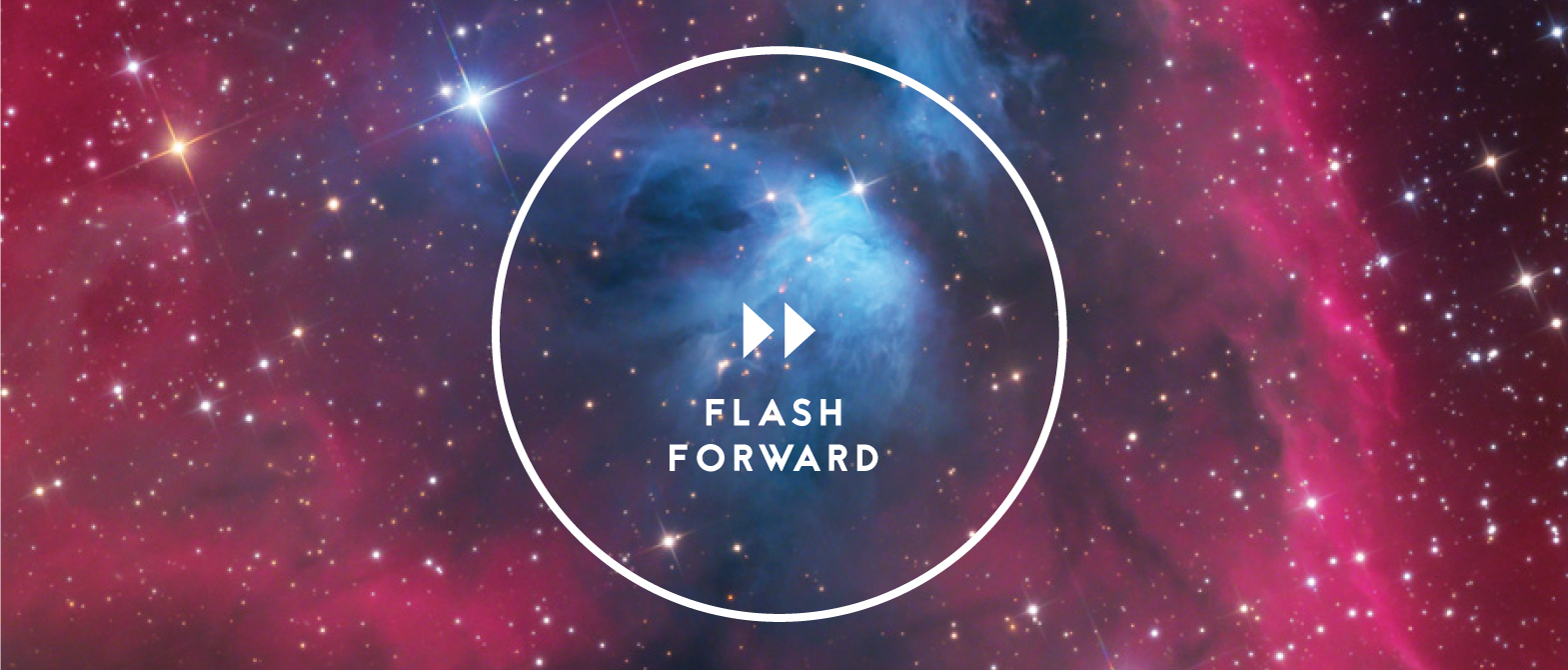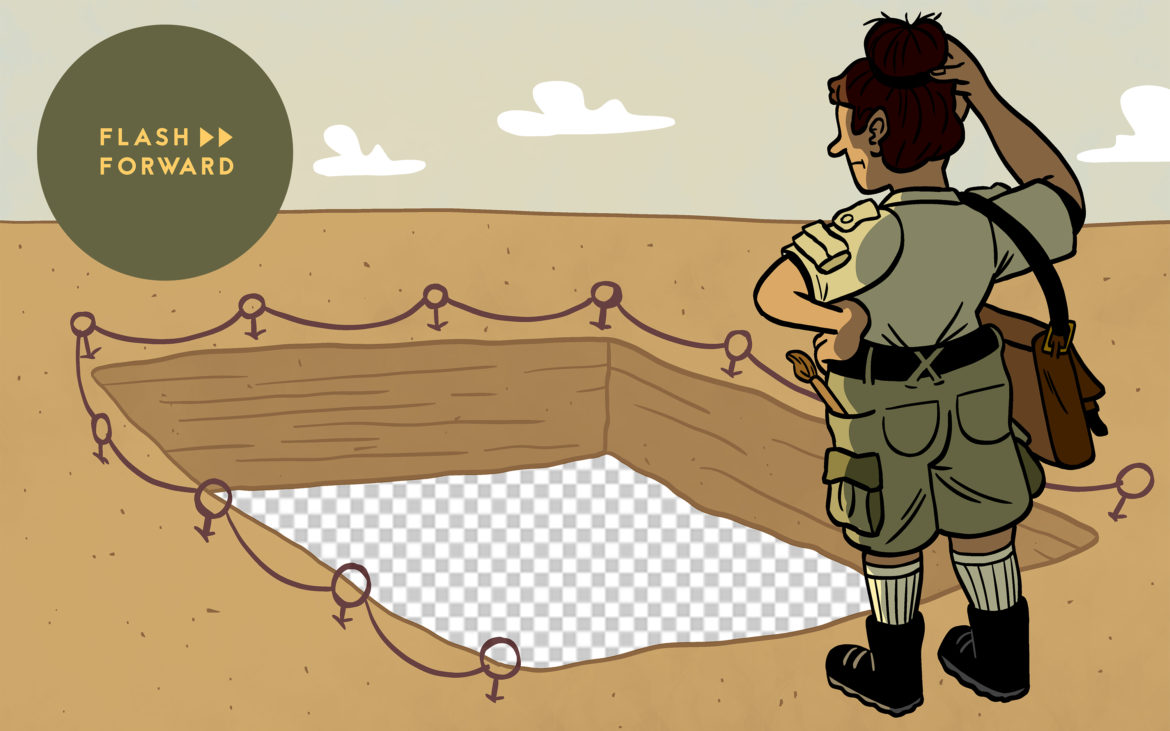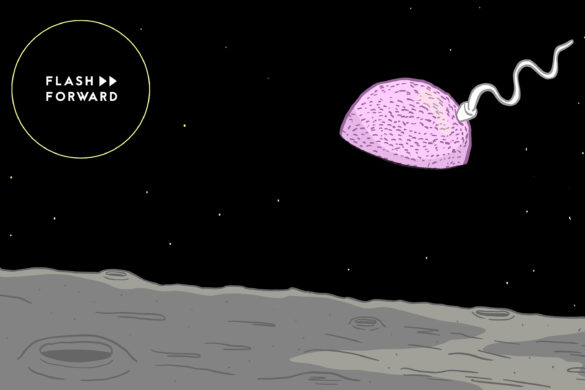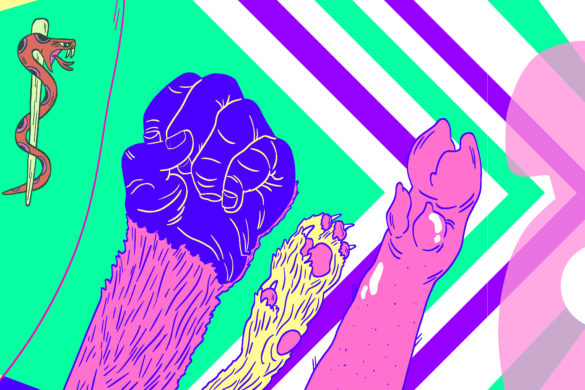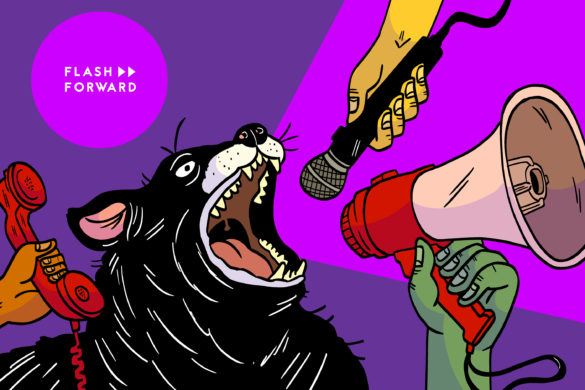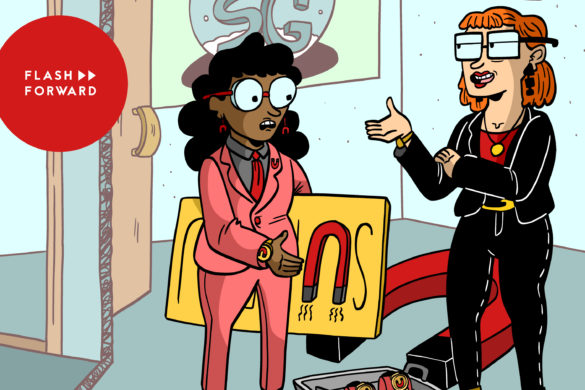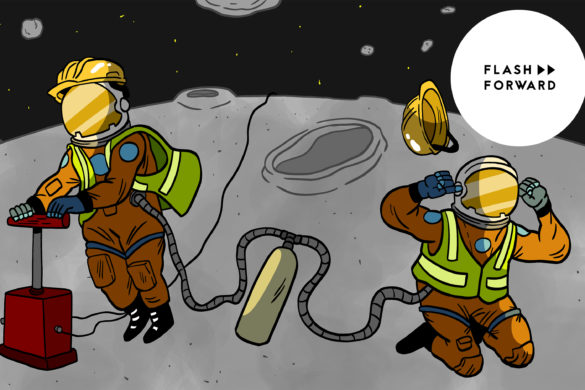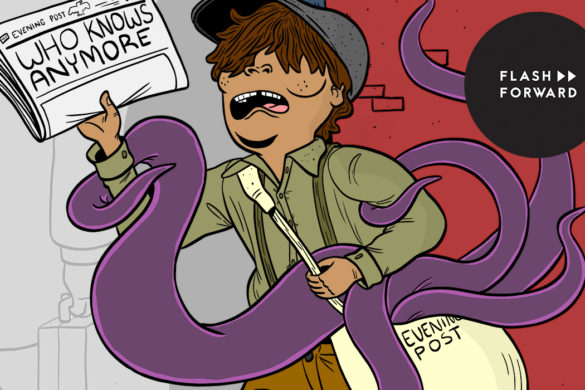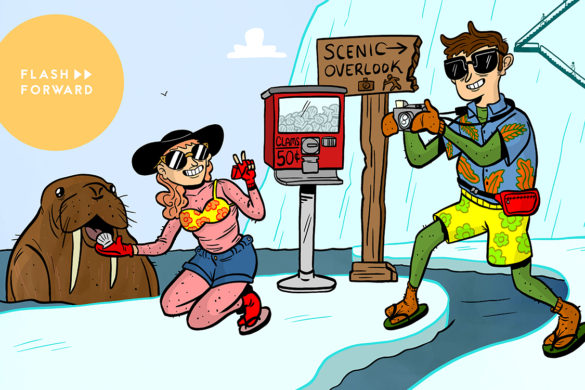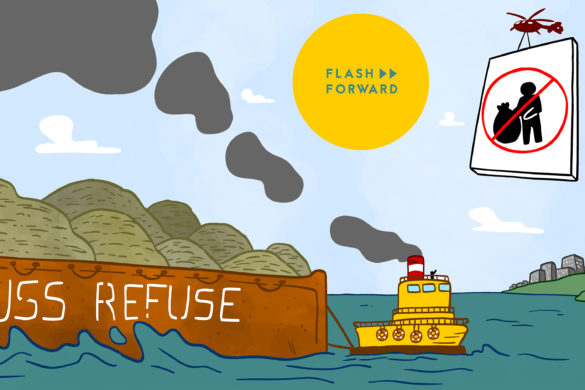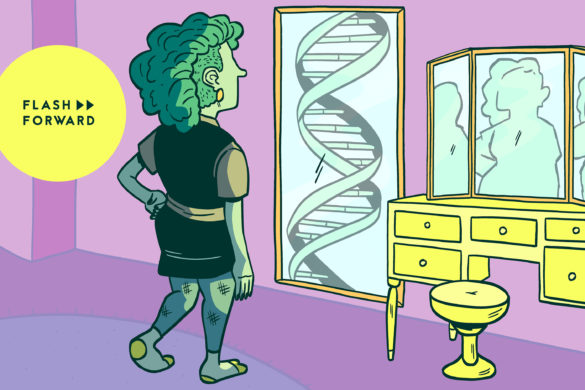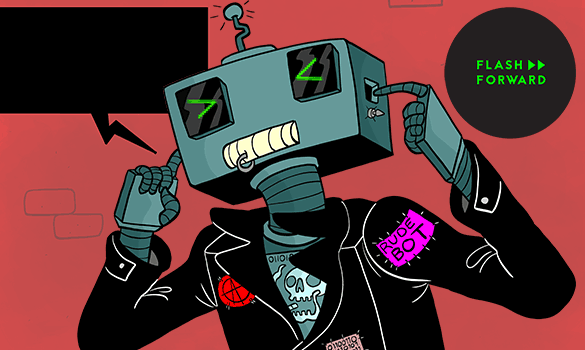Today we travel to a future where archaeology accidentally runs out of usable ancient DNA.
Guests:
- Dr. Keolu Fox — assistant professor at UC San Diego, Indigenous Futures Lab
- Dr. Benjamin Vernot — postdoctoral scientist at the Max Planck Institute for Evolutionary Anthropology
- Dr. Naomi Martisius — postdoctoral scientist at the Max Planck Institute for Evolutionary Anthropology
Voice Actors
- Dr. Pastrana — Ashley Kellem: Instagram, Website
- Graudate Student — — Henry Alexander Kelly: Website, podcast La Lisa: A Latinx Podcast
Further Reading:
- A Draft Sequence of the Neandertal Genome
- Neither femur nor tooth: Petrous bone for identifying archaeological bone samples via forensic approach
- DNA has a 521-year half-life
- A minimally-invasive method for sampling human petrous bones from the cranial base for ancient DNA analysis
- Optimal Ancient DNA Yields from the Inner Ear Part of the Human Petrous Bone
- Use ancient remains more wisely
- Why Scientists Should Celebrate Failed Experiments
- Scientific progress is built on failure
- Highlight negative results to improve science
- Archaeological looting
- Native South Americans were early inhabitants of Polynesia
- Diverse Plant and Animal Genetic Records from Holocene and Pleistocene Sediments
- No bones? No problem: DNA left in cave soils can reveal ancient human occupants
- Neanderthals ‘knew what they were doing’: Archæologist Dr Naomi Martisius discusses her findings about Neanderthals’ behaviour with Wikinews
- Getting under the skin of a Medieval mystery
- Ancient dental plaque: a ‘whey’ into our milk drinking past?
- ZooMS: Species identification of parchment using peptide mass finger printing
- If Neandertals had a bone to pick, which would they choose?
- Identifying Archaeological Bone via Non-Destructive ZooMS and the Materiality of Symbolic Expression: Examples from Iroquoian Bone Points
- Non-destructive ZooMS identification reveals strategic bone tool raw material selection by Neandertals
Episode Sponsors:
- PNAS Science Sessions: Short, in-depth conversations with the world’s top scientific researchers. Listen wherever you get your podcasts!
- Shaker & Spoon: A subscription cocktail service that helps you learn how to make hand-crafted cocktails right at home. Get $20 off your first box at shakerandspoon.com/ffwd.
- Tab for a Cause: A browser extension that lets you raise money for charity while doing your thing online. Whenever you open a new tab, you’ll see a beautiful photo and a small ad. Part of that ad money goes toward a charity of your choice! Join team Advice For And From The future by signing up at tabforacause.org/flashforward.
- Tavour: Tavour is THE app for fans of beer, craft brews, and trying new and exciting labels. You sign up in the app and can choose the beers you’re interested in (including two new ones DAILY) adding to your own personalized crate. Use code: flashforward for $10 off after your first order of $25 or more.
- Purple Carrot: Purple Carrot is THE plant-based subscription meal kit that makes it easy to cook irresistible meals to fuel your body. Each week, choose from an expansive and delicious menu of dinners, lunches, breakfasts, and snacks! Get $30 off your first box by going to www.purplecarrot.com and entering code FLASH at checkout today! Purple Carrot, the easiest way to eat more plants!
Flash Forward is hosted by me, Rose Eveleth and produced by Julia Llinas Goodman. The intro music is by Asura and the outtro music is by Hussalonia. The episode art is by Matt Lubchansky.
If you want to suggest a future we should take on, send us a note on Twitter, Facebook or by email at info@flashforwardpod.com. We love hearing your ideas! And if you think you’ve spotted one of the little references I’ve hidden in the episode, email us there too. If you’re right, I’ll send you something cool.
And if you want to support the show, there are a few ways you can do that too! Head to www.flashforwardpod.com/support for more about how to give. But if that’s not in the cards for you, you can head to iTunes and leave us a nice review or just tell your friends about us. Those things really do help.
That’s all for this future, come back next time and we’ll travel to a new one.
FULL TRANSCRIPT BELOW
▹▹ ▹▹ ▹▹ ▹▹ ▹▹ ▹▹ ▹▹ ▹▹ ▹▹ ▹▹ ▹▹ ▹▹ ▹▹ ▹▹ ▹▹ ▹▹ ▹▹ ▹▹ ▹▹ ▹▹ ▹▹ ▹▹ ▹▹
FLASH FORWARD
S6E010- “Game of Bones”
[Flash Forward intro music- “Whispering Through” by Asura, an electronic, rhythm-heavy piece]
ROSE:
Hello, and welcome to Flash Forward! I’m Rose, and I’m your host, and Flash Forward is a show about the future. Every episode we take on a specific possible… or not so possible future scenario. We always start with a little field trip into the future, to check out what’s going on, and then we teleport back to today to talk to experts about how that world we just heard might really go down. Got it? Great!
This episode we are starting in the year 2055.
FICTION SKETCH BEGINS
[A knocking on the door]
GRADUATE STUDENT:
Dr. Pastrana, hi! Do you have a minute?
DR PASTRANA:
Sure, of course.
[The student enters the office and shuts the door behind them]
GRAD STUDENT:
I think I know what I want to focus on for my thesis.
DR PASTRANA:
Oh good, I was starting to worry about you!
GRAD STUDENT (slight nervous laugh):
Yeah, I just have a lot of interests I guess.
DR PASTRANA:
Not always a bad thing! But.. sometimes a bad thing. So, what are you thinking?
GRAD STUDENT:
I really loved the guest lecture that Dr. Minoan did a few weeks ago, and I’ve been doing some of my own research into it, and I think I want to look into this question of Bronze Age cultural changes across Eurasia, especially language changes! It’s so interesting to me that we just don’t know what caused these– Did the ideas move, or did the people move?
But that seems like a question we could totally answer, we just have to do more work on the DNA, right? I’ve tried to find one, but I don’t think there’s a big, broad comparative study that samples across all of Eurasia to understand how human DNA moved over time. It’s actually really weird that there isn’t a study like that, honestly, but I thought maybe that’s what I could do!
DR PASTRANA (..how to say this?):
Ah, yes- um.. you’re right that there isn’t a study like that.
GRAD STUDENT:
Which is good for me! I could do it, and it would be a real contribution to the field!
DR PASTRANA:
Well. There’s a reason there’s no study like that. Unfortunately, there’s really no way to do that study.
GRAD STUDENT:
Why not?
DR PASTRANA:
As you said, you’d need a broad set of samples from the time period, and we just don’t have them.
GRAD STUDENT:
..What do you mean we don’t have them? I’ve read a ton of work from the 2020s on Bronze Age DNA.
DR PASTRANA:
Right, and have you noticed that there hasn’t been much published on that time period at all recently?
GRAD STUDENT:
Yeah, it seems to stop around… 2029.
DR PASTRANA:
Why do you think that is?
GRAD STUDENT:
I don’t know. There are always trends in what research is considered sexy and what isn’t.
DR PASTRANA:
That’s true, but that’s not what’s happening here. You’ve stumbled upon a sort of, dirty secret in archaeology. For a long time, our sampling methods were destructive— to get DNA we had to grind into the bones. And when the boom in archaeological genetics happened, everybody got excited.
Everybody was doing all sorts of really interesting work, and nobody was really keeping track of how much was being used. Until it was kind of.. too late. Bronze Age stuff was really popular to work on, and the samples that we still have intact are totally spent. There’s nothing left to extract from them.
[Brief pause]
GRAD STUDENT:
So what do people do if they want to study this stuff?
DR PASTRANA:
They find other ways.
GRAD STUDENT:
..Could we find more remains?
DR PASTRANA:
Possibly. I’m sure there are places we haven’t looked. But most of the remains in those places would, rightfully of course, go directly to the indigenous people there. So if you did manage to find new remains, you’d have to convince them to help you.
GRAD STUDENT:
Well, how does Dr. Minoan do his work?
DR PASTRANA:
That’s a good question that many of us would love the answer to. He has an exclusive contract with the Gree Museum, and they have a few samples remaining.
GRAD STUDENT:
So if I want to do this study, I have to talk to Dr. Minoan.
DR PASTRANA:
..He’s not known to share.
GRAD STUDENT:
So we just… won’t know more about this time period at all, basically?
DR PASTRANA:
No, that’s not true. We just won’t know about them through genetic analysis of the type you’re hoping to do. There are plenty of other ways to study a time period or group of people.
GRAD STUDENT:
Past humans sucked, huh?
DR PASTRANA:
Yes; so do current ones. It’s kind of part of what makes us human I think, for better.. or for worse.
[The grad student opens the door to leave]
FICTION SKETCH ENDS
ROSE:
Okay, so, today we are talking about the future of archaeology. And, specifically, the future of research into ancient humans and our close relatives like Neandertals.
And one of the best ways to understand these ancient creatures is by looking at their remains.
DR KEOLU FOX:
Using human remains for analysis is really important because it allows us to kind of connect with our deep past, like really deep.
ROSE:
This is Dr. Keolu Fox, a researcher at UC San Diego.
KEOLU:
Where I’m affiliated with the Department of Global Health, Anthropology and the Indigenous Futures Lab.
ROSE:
To connect with our deep past, archaeologists who study our long-dead ancestors use a whole suite of tools to analyze and piece together information from the bones they left behind.
KEOLU:
And there are various techniques to do this. There’s sort of, like, bone morphology stuff. There’s a bunch of kind of tissue identification stuff. Radiocarbon dating, of course.
ROSE:
And then, about ten years ago, a new tool was added to that toolbox: DNA. In 2010, scientists sequenced a piece of the Neandertal genome for the first time. And that was a huge deal. Today, there’s kind of an ancient DNA gold rush happening. Scientists have so many questions that they want to answer using the DNA of these ancient people.
KEOLU:
I am personally really interested in comparing genome sequence data derived from ancient genomes to modern genomes and using those cross sections in time to understand ideas around human genetic diversity.
So one thing I’m really interested in is understanding the sort of genomic diversity that might exist in pre-contact indigenous communities, and then the effect of the arrival of, of European pathogens via colonialism and how that affects population structure and how that causes a population collapse.
ROSE:
Using ancient DNA, researchers can explore things like how early humans moved around, the kinds of diseases they had, and even which ancient humans interbred with Neandertals. But, there’s a catch: Extracting DNA from these ancient bones is not easy.
KEOLU:
The DNA is not just accessible in the same way it is in living modern humans. You have to think about, like, the weathering process and the way things deteriorate and degrade. DNA itself is sort of like a polymer or a ribbon, and these chemical bonds degrade over time.
ROSE:
Over thousands of years, these bones decay, and the DNA inside of them breaks down. At this point, most of an ancient skeleton isn’t going to have DNA in it. There are only certain pieces, deep inside and protected from those weathering forces, that are likely to still contain usable genetic material. Teeth are great candidates, for example, because the tooth itself protects the material inside. And there’s one spot that’s even better:
KEOLU:
There’s a part of the human skull called the petrous bone, which is sort of like this little gyroscope or.. onion almost in a way, and that it has, like, layers of bone around it that protect a- this petrous portion, which is a really good place to get DNA. So that becomes coveted, because you know that if you can basically crack open a human skull and get access to this petrous portion, then you’re going to have a really high chance of having good quality DNA to be sequenced.
ROSE:
The petrous bone is kind of the hidden gem of every ancient skeleton, at least when it comes to DNA. In some cases, scientists have been able to extract one hundred times more DNA from the petrous bone than any other part of the body. But it’s also a pretty small bone located deep inside the skull. To get to it, you have to drill through what’s called the cranial vault, and to extract DNA, you have to grind a piece of it into dust.
And some researchers, like Keolu, are starting to worry that in all the excitement around the possibilities presented by ancient DNA, the field might accidentally blow through the specimens they have.
KEOLU:
More ancient genomes have been sequenced in the first 10 months of 2019 than the entirety of history.
ROSE (on call):
Yeah, and is anybody keeping track of these samples? In terms of.. who’s using them, how- if they’re being overused, if certain samples are at risk, like- is there any kind of, like, record-keeping here?
KEOLU:
That is a great question. To my knowledge, there isn’t much of a system for record-keeping. You will hear about it when experiments work because they will be the mainstay featured on a marquee journal like Science or Nature, you know, ‘Neandertal genome,’ ‘Denisovan genome,’ but no one really talks about the negative results, i.e., how many attempts did you, you know, or experiments did it take for you to get to the point where you can talk about this data?
ROSE (Mono):
This point about negative results is a huge problem in almost every field of science— studies only get published when your experiment works, and you find something out. But most experiments don’t work; most of the time stuff doesn’t turn out the way you wanted. And all those times you tried and failed, nobody really knows about them but you and your lab mates.
And that can cause not just duplicated efforts because people aren’t sharing the stuff the doesn’t work with one another, it can also obscure the amount of material that’s actually being used. In the case of archaeology, you might publish a study on one bone, but you actually tested five to get there that aren’t mentioned.
KEOLU:
So, no, there isn’t really a good system for understanding what is held where, and what is being destroyed, and who has access to what, and what is its provenance, and where was it from 1921 to 1945, and so on and so forth. So we really need to build those types of systems.
ROSE:
Last year, Keolu wrote a piece with Dr. John Hawks for Nature, sounding the alarm and calling for the field to think a little bit more carefully and a little bit differently about the ways these studies are done. Without a change in course, Keolu argues that we could be headed towards a really sad future.
KEOLU:
I see one future where this is really dark, and.. we… run out of this finite resource. And that’s highly problematic because what we really need is a bit more patience.
ROSE:
And archaeology has done this kind of thing before— in the early days of the field, it was a lot more like looting than science. Entire tombs and regions were stripped clean, and artifacts were damaged or removed from their context, or just lost.
Even more recently, in the 1990s, pretty big sections of ancient human skeletons were destroyed for radiocarbon dating. If they had waited just a little bit longer, the techniques would have advanced, and they could have destroyed much smaller pieces and left more behind for future researchers.
And it’s not just about being more careful with the specific techniques they’re using. Keolu also sees this question of resource management as a question of who is doing this work, and to what end. When we spoke, Keolu pointed out that only a handful of labs are getting access to a lot of these samples.
KEOLU:
And that’s just really a dangerous, dangerous idea, if only a handful of laboratories get to interpret that information and basically repatriate the deep past of our whole species, right. There should be more of a consensus-building process in the way that we understand that information.
So if it’s all white European males that are interpreting the history of our whole species, then who do you think that’s going to serve? That is another kind of ominous and dark future in that, in that there are a lot of mistakes that are made in the way that we design algorithms and the way that we interpret digital sequence information. And if that isn’t a process where we involve more stakeholders, then that’s only going to serve, you know, one community of people.
ROSE:
So how do we avoid this future? Well for one thing, Keolu proposes that large institutions, like the Smithsonian, should link up and try and keep track of who is using which remains for what to try and get a better, high level picture of the overall rate at which researchers are going through this precious material.
And he also thinks it’s time for archaeology to really fundamentally rethink a lot of how it functions.
KEOLU:
Whose questions are we asking? How are we interpreting this data? Who is making the comparisons and, and really designing the algorithm to think about the way we use ancient genomic information as a resource?
It’s so important to understand the mistakes we’ve made in the past so that we, we kind of recalibrate and correct course. We have this saying in Hawaii, “I ka wā mamua, I ka wā mahope.” “We’re walking backwards into the future.” We’re recognizing all of our history of mistakes that we have made in order to form a healthier future.
ROSE:
What that means for ancient DNA sampling specifically, is for the research community to really think about which questions get priority, and whether you actually need DNA to answer them.
KEOLU:
No one has ever asked the community what their priority is and what those questions are. I don’t think the scientific community broadly has enough imagination to actually source questions from the indigenous communities that they’re working with, the modern descendants that they’re working with. I can assure you that if they were to do that, the papers would come out a lot stronger and they would get a lot less kickback from the communities that they’re treating like, you know, baseball cards at this point.
For example, there was a recent paper that was published in Nature and they showed, using, kind of, genome sequence or array data that Polynesian people made it all the way to South America. Now, if you’re Polynesian and you know our history and you know all of the other lines of evidence, including but not limited to linguistic data, flora and fauna and genomic data, and archeological data, and local history data, you would know that it’s well validated and pretty much already been proven that if you had a mastery of voyaging and navigational technology, so much so that you found Hawaii and the Marquesas, then why would it be hard for you to identify a whole continent in South America? You would find it. It would not be challenging at all.
So to kind of go back to the well and reinvent or resell a narrative that has already been proved in a lot of different ways using genetic data, it does- it’s, like, it’s not in service to the holistic approach of science, right?
ROSE:
If these petrous bones are a super rare and valuable resource, is it really worth grinding them up to answer questions that you might be able to answer in other ways? That might have already been answered in other ways, by other people and other sources of data?
KEOLU:
The version of science that we’re thinking about within the paleogenomics space really has to do with this recalibration where it’s more about growth towards cultural sustainability and involving more diverse stakeholders and not maintaining the status quo because the status quo is harming indigenous communities and their ancestors.
ROSE:
A couple of weeks ago we talked about the idea of decolonizing data— of talking to the community about what they need to know, and how they might want to find that out and how that data should be gathered and stored. Keolu is working in that very same vein, hoping to balance out the power between the subjects of research and the researchers themselves.
KEOLU:
And so what I would like to see more of is allowing communities to prioritize the questions we ask and co-hypothesize and co-develop and not co-opt ethics in a way to get access to ancient remains, but actually genuinely, authentically build projects that serve the communities that actually have impact in the communities that help them repatriate their deep past and strengthen their identity today. And, most importantly, carve out a brighter and healthier future for them and their descendants.
ROSE:
And Keolu thinks that this wouldn’t just impact archaeologists who study ancient DNA, a small but mighty cohort of people. Instead, his work at the Indigenous Futures Lab, is hoping to take this same approach to lots and lots of places and make some big changes in the broader culture.
KEOLU:
Listen, cultural sustainability is good for everyone. When we talk about diversity, it’s good for everyone. When we talk about equity, it’s good for everyone. And in this space, that’s no different. When we allow for a, a new space and a new perspective and prioritize questions that are not just, like, locally specific to the knowledge, but really engage the community in this kind of iterative process of honing in on better and better questions that could help us think about the past in new ways, now we’re talking about innovation. Now we’re talking about some seriously new questions that we’ve not even approached before that we can’t even imagine.
And that’s the future that I would like to see. That’s what we’re trying to build here at the Indigenous Futures Lab, are ways to empower our communities so that this science actually has an impact in a sustainable way, whether it’s related directly to climate change, its sustainability or cultural sustainability. That’s what we’re trying to build here.
ROSE:
Most archaeologists aren’t, like, cackling while they grind up human bones left and right. Most people in the field recognize that the choice to do destructive sampling is a really serious one that should be considered carefully. And compared to other methods, like radiocarbon dating, DNA sampling isn’t even the most destructive.
But what would happen if we sort of stumbled into a world where all those little petrous bones on the human remains that we do have have been ground to dust? Well, it turns out there are some really interesting other ways to get information about humans, and when we come back we’re going to talk about a few really cool future archaeological methods that don’t require destructive sampling at all.
BENJAMIN VERNOT:
Yeah, there’s absolutely quite a bit of skepticism, and it still seems sort of like magic.
ROSE:
But first, a quick break.
ADVERTISEMENT #1: GET WIRED
ROSE:
Hey, if you like Flash Forward, I want to tell you about another podcast that you might like as well. It’s called Get WIRED, and it’s a new podcast from (slight laugh) yes, WIRED, hosted by senior writer Lauren Goode about how the future is realized. It’s news from tomorrow, delivered to you today. (audibly smiling) That sounds like something you would like, right? (laughs)
WIRED is nerdy, innovative, and research-heavy. It’s trustworthy journalism informed by decades of real understanding of technology. And it helps us make sense of a world in constant transformation. The breakthroughs that they uncover lead to new ways of thinking, and new connections.
WIRED is bringing that level of hard-hitting reporting, intimate storytelling, and fresh perspective to audio. Every week they burrow down a new rabbit hole to investigate the ways technology is changing our lives, from culture to business to science and design.
Flash Forward listeners might be extra interested in a recent episode called “The Rise of Virtual Beings,” where they attended a virtual beings summit, and talked about what it even means to be human– and revealed that while you may not think you’ve interacted with a virtual being recently, you probably have. Oh, there’s one right now.
With new episodes dropping every Monday, Get WIRED will set the tech agenda for the week rather than responding to it. Listen and subscribe to Get WIRED, wherever you get podcasts.
ADVERTISEMENT #2: PNAS SCIENCE SESSIONS
ROSE:
This episode is sponsored in part by PNAS Science Sessions.
Science Sessions are short, in-depth conversations with the world’s top scientific researchers. In less time than it takes to drink a cup of coffee, you can learn about why, for example, women are underrepresented in STEM fields and what we can do about it.
So, you all know that I am really passionate about the ways in which science can be more inclusive and more diverse and thereby more interesting. In order to bring more voices into the field, you kind of need to know why they have been excluded in the first place, and what the barriers are folks who might want to become scientists, but who wind up being pushed out, for some reason.
And on a recent episode of Science Sessions, you can hear from Donna Shalala, Marcia McNutt, and Fabiola Gianotti about the latest research into this question. Studies show that there are a handful of things that push women out of these fields. Things like lack of childcare, sexual harassment and discrimination, lack of access to education, and the perception, even among really young kids, that science and math are just not for women.
One thing that I learned from this episode that I did not know before is that one national academy’s report found that the field with the second highest rate of sexual harassment is medicine— the first is the military– which probably helps explain why there is still such a big gender gap in medicine when women are entering the field in pretty high numbers.
To learn more about this work, and what some of the solutions might be, check out Science Sessions wherever you get your podcasts.
ADVERTISEMENT BREAK END
ROSE:
Okay, so, let’s say that the gold rush of ancient DNA research continues and suddenly, future researchers, like the one you heard in the intro, find themselves without specimens to sample. What happens next?
Well, one thing you could do is try to find more samples. There are certainly more humans in the ground than we’ve found– so far. But that’s easier said than done. Even in places where researchers know early humans lived, they can’t always find bones. But! What if I told you, you didn’t always need human remains to find human DNA?
BENJAMIN VERNOT:
We have a– an analysis that I hope should be coming out soon where we really, I think, have done great things, really interesting things, trying to elucidate the histories of manifolds from sediment DNA. It’s to me, still sort of magical.
ROSE:
This is Dr. Benjamin Vernot, a researcher at the Max Planck Institute for Evolutionary Anthropology. And Benjamin’s research has recently focused on sampling and analyzing human DNA that comes from the Earth. Like literally the Earth, the sediment, the soil, the dirt in the ground.
ROSE (on call):
So where is that DNA coming from?
BENJAMIN:
Yeah, that’s, that’s a really excellent question, and- to be honest, I don’t think we really know. I think that one can speculate quite a bit and make some educated guesses. So when you find DNA in a cave, the majority of what you find is, say, bear DNA from animals that maybe didn’t die in the cave, but could have left large amounts of feces or hair or urine. My, my best guess is that it largely comes from, from poop.
ROSE:
Nice.
ROSE (Mono):
So wait. You might be wondering, as I was, how this is possible. Why is it that an actual human skeleton from forty thousand years ago degrades away and doesn’t have usable DNA, but it’s just, like, in the dirt somehow?
BENJAMIN:
There are actually some things about sediment that lend themselves to DNA preservation. So we’ve largely think that even in bones, that the DNA attaches itself and is preserved to a certain extent by the mineral elements in the bones. And so, you know, sediment is minerals, right. And so we think that it attaches itself to the minerals in the sediment and is possibly preserved there as well.
ROSE:
Researchers were first able to do this kind of analysis in 2003, when a scientist named Dr Eske Willerslev was able to get DNA out of a core from the Siberian permafrost.
BENJAMIN:
And there they mostly got DNA from plants, from permafrost, so we’re able to sort of look at turnover of different plants over time.
ROSE:
From there, the technique extended out to other non-human animals.
BENJAMIN:
There was a paper from 2009 where they were able to show that horses and mammoths survived in Alaska for much longer than had previously been thought.
ROSE:
And eventually, they got it good enough that they could actually start to find human DNA in these soil samples, often in places like caves that we know people lived in.
BENJAMIN:
So the best situation, sort of the optimal situation for us, is a previously excavated cave that has a face, right, like a wall that is, that is exposed a bunch of layers where there’s already archeological evidence that there were people there. And then you sort of just hon- honestly just stick a tube into the wall and twist it, and a little bit of dirt falls into the tube, and you move along to the next spot.
ROSE:
Once you have the dirt, you then have to make sure that you are actually sampling ancient DNA, and not stuff that might have been left behind from more modern humans who’ve been in the cave recently. And to do that, they basically look to see if the DNA has degraded in the way that they expect.
BENJAMIN:
And you can look for those patterns in the, in the DNA, and if you don’t see those patterns, right, if you don’t see this particular base breaking or mutating or being damaged in- at, sort of, the frequency that you’d expect it to be, then you can really tell quite clearly that it’s not ancient DNA.
And that degradation does complicate your analysis, right, because you’re essentially- you need to have evidence of crappy DNA (slight laugh) in your sample in order to believe it. But then when you have crappy DNA, it makes it more challenging to analyze. And that’s why this field is sort of interesting and challenging at the same time.
ROSE:
But even with that crappy DNA, you can get legitimate results that tell you about these ancient people! This is absolutely incredible to me! Fifty thousand years ago, some early humans pooped a bunch in a cave and now we can sequence the DNA left behind and learn about them even if they didn’t leave their bodies!
Most of the time this is data that tells us about a population. Not an individual human that might have lived in the cave. But that’s often what researchers are looking for anyway— they want to understand how different populations moved around, and whether they bred with one another. When they arrived. How long they lived in a place.
And right now, there is some really exciting work going on in this field to answer some of those questions… a lot of it so new that Benjamin actually can’t tell me about it.
BENJAMIN:
To be honest, I don’t know exactly how much to say, because some- I think there are really cool things that are going to happen, but they’re all not published yet. (laughing) Sort of confidential, you know, so.
ROSE (on call):
I know; I’m trying to goad you into, like, revealing your secrets (laughs)
ROSE (Mono):
So, just to be clear, Benjamin is not keeping this a secret for any (slight laugh) nefarious reasons. In science there’s this weird rule called the “Ingelfinger Rule–” yes, that is, indeed, what it’s called– where you are not allowed to talk about your research until it’s published in a journal, otherwise that journal could decide to pull your study. Whether that is actually a good rule is a topic for another podcast, but what this really means is that there is some really exciting stuff that is about to be published on this topic!
And the idea that there might just be DNA, laying around in the dirt, everywhere, just waiting to be analyzed, is really exciting!
ROSE (on call):
Maybe this is, like, totally out there and bizarre, but I will say that, like, reading about this and talking to you makes me want to just go out in my backyard and dig a hole, and be like, “maybe there’s some DNA down there!”
BENJAMIN (laughing slightly):
Yeah. I mean I.. yeah. Probably not in California. But I think that yeah, that’s absolutely something that I have thought of. We have a small garden and I oftentimes want to just dig up some dirt and see what sort of DNA is in it.
ROSE:
Have you not done it yet, though?
BENJAMIN:
No, I have not. I’m not allowed in the lab, and so it’s a little bit, you know, it would be challenging for me to enact that dream.
ROSE:
Why are you not allowed in the lab?
BENJAMIN:
Oh, I’m sorry. That’s, that’s a joke. I’m a computational person, and so I don’t–
ROSE (overlapping):
Oh!
[They both laugh]
ROSE (cont’d):
It’s like, “Oh, after the incident last year, not allowed..”
BENJAMIN (laughing):
No, yeah, exactly. Well, ever since the big fire, you know.
[Rose laughs]
BENJAMIN (cont’d):
No, no, no.
ROSE (Mono):
But before we get too excited, it’s also worth considering a couple of questions of ethics and DNA collection, with this method.
If I were to go out into my yard and dig a hole and find an ancient body, I would be legally and ethically mandated to figure out whether there are living descendants of that person. This is a big topic in research in archaeology, making sure that you’re respectful of the remains you’re dealing with. When we’re talking about Neandertals from 50 thousand years ago, this isn’t really an issue; there’s no one living group today that makes sense to say is a descendant. But when you’re talking about more recent remains, this is a big question. And when you’re just finding DNA in soil as opposed to bones, it gets kind of complicated.
BENJAMIN:
A situation that I can imagine is: someone comes and they take sediment, they take sediment from an area where there is a Native American tribes that owns or used to own or should own that land. And.. someone takes sediment from it and gets DNA from it and then publishes findings sort of about those groups of people and doesn’t feel as though they need to engage that group of people in the same way that they would if there were bones, right. That they would legally have to if there were bones, even.
And so- I wouldn’t want that to happen? I would, I would hope that this is still DNA from a group of people. I think that one should still try to be consciences- conscientious about that. So, yeah, I think it’s an important question and I hope it’s one that people don’t just see sediment DNA as sort of- a loophole or a workaround.
ROSE:
Last year on an episode, we talked about the DNA that people leave behind at a crime scene, or even just at a police precinct, which is kind of similar. Right now, the US legal system considers DNA that you might leave on a doorknob or a chair that you sat on, the same way that it considers garbage. Which means that you don’t have any right to it; the law doesn’t protect it.
But as we said on that episode, that’s kind of weird right? You’re not choosing to throw away your DNA; you have no choice in the matter at all, you can’t control it. And the same questions arise here— these ancient humans didn’t choose to have their DNA bound up in the soil. And these are questions that this field is going to have to grapple with.
This method is still really new, and the DNA that comes out of soil is often not that good. There are tons of improvements that Benjamin would like to see. But it’s also a really exciting time.
BENJAMIN:
I mean, when you talk with archeologists about this and presented this at a few conferences, you can see in their eyes sort of the– Okay. This dirt is a resource.
ROSE:
And this method could also help us understand what was happening in places that are really hard to study, like underwater sites.
BENJAMIN:
You know, there’s quite a bit of the, of the Earth that was accessible to human habitation, and maybe would have been preferential because it- because it was close to the shore, that is now under water. In my dream world, we would go to get marine sediments and get ancient DNA from them.
ROSE:
But it’s not just DNA techniques that are getting really exciting. There are also some really amazing nondestructive methods that are changing the future or archaeology. If you think getting DNA out of soil seems like magic, hoo, buckle up, it’s about to get even more mind blowing.
But first, a quick break.
ADVERTISEMENT #3: SHAKER & SPOON
ROSE:
This episode is supported in part by Shaker & Spoon. Shaker & Spoon is a subscription cocktail service that helps you learn how to make handcrafted cocktails right at home.
Right now, you are probably not going out to your favorite bar to get your favorite drink. And if you are, hopefully you’re getting it to go. And if you’ve been missing that Negroni or Old Fashioned or the way that a bartender can surprise you with a new drink that you’ve never had, Shaker & Spoon is a great way to tap back into that feeling.
Every Shaker & Spoon box comes with enough ingredients to make three different cocktail recipes developed by world-class mixologists. All you need to do is buy one bottle of that month’s spirit, and you have all you need to make twelve drinks at home.
At just forty to fifty dollars a month, plus the cost of the bottle, it’s a super cost-effective way to enjoy craft cocktails. And you can skip or cancel boxes at any time!
And if you’re not a drinker, a lot of the recipes I saw in the Shaker & Spoon booklet seemed like they could totally work without the alcohol, with a little bit of soda water, or even on their own.
Shaker & Spoon is a great gift for yourself or your cocktail-loving friend who wants to try new things. And if you try Shaker & Spoon today, you get twenty dollars off your first box, at shakerandspoon.com/ffwd. That’s shakerandspoon(dot)com slash FFWD
ADVERTISEMENT #4: TAVOUR
ROSE:
This episode of Flash Forward is brought to you in part by Tavour.
Do you ever go into the grocery or liquor store and feel totally overwhelmed by all of the beer choices? There are so many cool local breweries and cool, interesting beers these days, and I’m going to admit that I often just buy stuff because the label is cool- like recently, we bought a beer that just has a dog in a costume on it because it has a dog on a costume on the label.
But if you want to get serious about your beer aficionado status and support independent breweries, you have to try Tavour. Tavour ships the best and rarest beer right to your doorstep from independent breweries around the world. Members get to choose which beers they want, and they’re constantly adding to the selection: Two new beers are added to the app every day.
You pay for the beers as you add them to your crate, and then ship whenever you’re ready right to your doorstep. It’s that easy.
Download the Tavour app today and use the code FLASHFORWARD for ten dollars off after your first order of twenty-five dollars or more. That’s Tavour, T-A-V-O-U-R, and use the code ‘FLASHFORWARD’ for $10 off your first order of $25 or more.
ADVERTISEMENT BREAK END
ROSE:
Okay, so these DNA techniques are really cool and are getting more and more sensitive over time. But DNA isn’t the only way to understand an ancient population. And the future of archaeology is not just DNA evidence.
KEOLU:
We are prioritizing genetics as a line of evidence over every other line of evidence. And, and that is.. really problematic because, you know, archeological data exists, linguistic data exists. Ethnographic old data exists. Local histories exist. And sometimes these are sufficient for answering the questions that we want to answer and understand. A lot of what happens s this colonial perspective of “I’m going to sequence this genome because I can.”
ROSE:
That’s Dr. Keolu Fox again. There are so many other ways to learn about ancient humans that don’t involve grinding up bones to do DNA sequencing.
DR NAOMI MARTISIUS:
I, yeah, from my point of view, it’s kind of a shame that some of these other methods for assessing each humans don’t get as much attention when they might be just as interesting or maybe even more interest. I mean, I guess it depends on the person.
ROSE:
This is Dr. Naomi Martisius, a postdoctoral researcher who also happens to work at the Max Planck Institute for Evolutionary Anthropology in Leipzig, Germany. And Naomi studies the Paleolithic.
NAOMI:
And often I’m studying humans at about 40 to 50, or maybe even longer- thousand years ago.
ROSE:
And more specifically, Naomi often looks at the tools that ancient humans and our close relatives, Neandertals, made out of bones. Finding these tools is really hard, and they’re really rare, and usually you’re finding pieces of them, these little precious shards. Which means that Naomi does not do destructive sampling on them.
NAOMI:
So if it’s you only have a couple of this particular type of bone tool, probably don’t want to destroy it because maybe there’s some sort of technique in the future that will become available where you don’t have to actually destroy it to learn the same thing that you were going to learn.
ROSE:
And one of the really cool, recently discovered nondestructive methods out there, at least in my opinion, is called ZooMS.
NAOMI:
Should I just say it right here? ZooMS, or zooarcheology by mass spectrometry.
ROSE:
ZooMS is not trying to gather DNA. Instead, it’s a method of sampling and analyzing collagen, a kind of protein. Collagen is the most abundant protein in the body of mammals, and it can be found in skin, tendons, your eyeball— all over the place. And if you gather the collagen from a sample, you can tell a couple of things about it:
NAOMI:
From the mass of the peptides that are found in the sample, you can then tell what species, or sometimes you can’t even get to specific species, but you can get to a group of species, like a family of animals.
ROSE:
One of the really cool applications of ZooMS has been in the analysis of parchment samples— writing material made out of animal skins. If you want to know what kind of animal that parchment was made of, you can often use ZooMS to figure it out.
A couple of years ago, a team at the University of York developed a really cool way of doing this, gathering up collagen from a parchment without having to snip off a piece of it. Instead, they simply used a little eraser, and rubbed that eraser on a corner of the parchment.
NAOMI:
From that analysis, it was proposed that.. what was happening was as you rub the eraser on the parchment, the interaction of the eraser on the parchment causes, like, this static electricity. And so what’s happening is the plastic from the eraser is pulling out the oppositely charged collagen molecules from the parchment.
ROSE:
From there, the team wondered what else might have enough static electricity to pull tiny bits of collagen out of a sample without damaging it, and they tried sampling the plastic bag that a few bones had been stored in.
NAOMI:
When you curate a bone in a bag, there is some rubbing happening in there anyway; you’re just, like, carrying the bag from one room to the other. There’s something happening. The bone is moving. So the idea is that the plastic in the bag is then pulling out the collagen from the bone.
ROSE:
And, incredibly, this worked! They were able to get positive results just by sampling the container that a bone had been stored in. A couple of years ago, Naomi saw a presentation by this University of York team about this method, and decided to try it herself on a few pieces of Neandertal bone tool in her own work. Now, it was not a given that this would work, because the York team’s experiment was on much younger samples than the ones that Naomi handles.
ROSE (on call):
Was there ever any debate about whether to even bother trying this for you ‘cause it was- it’s so much older?
NAOMI:
Um… (exhale) I mean, not really, because- I mean, maybe if it was a super expensive method, then, you know, we might think twice about that, but doing this type of analysis doesn’t really cost that much. And because it is nondestructive, it’s not costing the artifact much either, right. Just like, why not? Why not just go ahead and try it?
ROSE (Mono):
So they sampled the plastic boxes that the bones had been stored in, and for four of the five samples they got positive results. Which- I mean this honestly feels like magic, right? You just swab the box that the stuff was stored in and you can tell what species the bones came from? Personally, my mind is blown! And in fact, I am not the only one:
BENJAMIN:
Yeah, I mean, as far as I’m concerned, that actually is magic. I don’t know. (laugh)
ROSE:
And the extra cool thing about this is that the results they got give us new insight into Neandertals and their ways of thinking. So the specific samples that they did this study on were on these tiny pieces of Neandertal tools.
NAOMI:
Neanderthals made some bone tools out of animal ribs. And when we first looked at them, because they’re so small and fragmented and also they’re made out of the ribs, ribs aren’t that distinct. It was really hard to tell what animal they came from.
ROSE:
The tools that Naomi used this method on, came from two different layers of earth, which means they have from two different time periods. In one of those periods, it was pretty cold and the main large animal species around were reindeer. In the other, there was more of a mixture of herbivores, some reindeer, some red deer, some Roe deer- a bunch of different types of deer basically. So researchers had assumed that these bone tools were likely made from reindeer or some other deer.
But! What the ZooMS analysis found, was that these tools were not made from reindeer, or any other kind of deer at all! They were actually made from either bison or auroch, a now extinct cattle like animal. So even though the Neandertals were hunting and seeing these medium sized creatures like reindeer way more often, they chose to make their tools out of bigger animals like bison.
NAOMI:
So whenever these Neanderthals happen to hunt a bison, come in contact with them in some way, it seems like they took those ribs from those animals and utilized them for their tools, which is pretty neat.
ROSE:
That suggests that Neandertals knew the properties of the material they were working with. The ribs of bison are bigger and more rigid than the ribs of reindeer, which make them better suited for these tools.
NAOMI:
So Neandertals made and use these tools and I’ve no idea, like, what your opinion is about Neandertals, (slight laugh) but I think often in popular media or just like in the general, I don’t know, zeitgeist or something Neandertals are often portrayed as, I don’t know, brutes that are stupid and don’t know much. I don’t know. Dragging women by the hair or something. And I think that’s, you know, that’s an old antiquated view of Neandertals.
ROSE:
And all of this insight came without a single speck of DNA.
NAOMI:
You know, it’s kind of like a puzzle, like trying to build the story from, you know, teeny tiny fragments of bone or stone or whatever it is to try to understand how these people lived and what they did in the past. You know, it’s, it’s not just about who they were, right? It’s, it’s how they were living.
ROSE:
And the future techniques of archaeology, they will likely involve all kinds of really interesting sampling methods, some of which will include DNA, and some of which will not. And at the same time, even the methods that are destructive are getting better and better as well, getting less destructive, basically. In the future we might be able to get all kinds of information without actually taking a skeleton out of the ground at all.
NAOMI:
Ground penetrating radar, I think is something really cool. We could speculate on where that might go or improvements to methodologies using that. Maybe at some point you won’t even have to dig, you know, (slight laugh) if that particular type of method gets so good you can see individual artifacts in the ground.
ROSE:
And really, the future of archaeology is all of these things. It’s using all these tools to create a complete picture of what was going on with our earlier ancestors.
BENJAMIN:
The coolest ancient DNA studies that have come out recently are ones that incorporated a bunch of other additional information, right. They were not just about the DNA. You know, each of these things has its strengths. The DNA is really good at elucidating broader population relationships and very specific familial relationships, right. You would never be able to say this is this person’s nephew without the DNA, unless they were- with Neandertals, was buried with a will or something like that.
ROSE:
That would be a pretty big discovery.
BENJAMIN:
That would be, that would be the paper of the year for sure.
[Rose laughs. He joins in.]
BENJAMIN (cont’d):
You know, so I really think that it’s- to me, it’s the exciting stuff in the field is going forward, sort of merging all of these technologies, all of which are getting better all the time.
ROSE:
The graduate student you heard in the intro could invent some new technique we haven’t even even thought of yet, some way of exploring our human past that nobody had considered.
And if all of this feels like magic to you, which it certainly does to me, think of how it might seem to a Neandertal. Sure, they were smart, making their bone tools, but I bet they would be pretty impressed by all of this. And in fifty thousand years, if humans are still here studying our remains, I bet the tools that they’re using would absolutely blow our minds too.
[A snapping, synthy music comes in- the Flash Forward closing theme]
ROSE:
Flash Forward is hosted by me, Rose Eveleth, and produced by Julia Llinas Goodman! Hooray! I’m so excited to have brought Julia on, and supporters got to hear from them on the bonus podcasts this week. Long time listeners know that this is the first time I have had any help making the show in five years, so it’s very exciting.
And that’s only possible because people donate to the show, so if you want to support the show and keep it growing and maybe make it possible for me to bring Julia on for more than just part-time or hire other people, you can figure out all the ways to do that at flashforwardpod.com/support. And that gives you a bunch of options for how to kinda give a little bit to the show to keep it going and to keep people like Julia on the team.
The intro music is by Asura and the outro music is by Hussalonia. The episode art is by Matt Lubchansky. The voices from the future this episode were played by Ashley Kellem and Henry Alexander Kelly, and you can learn about them in the show notes; please do go check that out; they have really cool projects.
If you want to suggest a future that we should take on, send us a note on Twitter, Facebook, or by email at info@flashforwardpod.com. We really do love hearing your ideas; some of the upcoming episodes are ones that people have recommended, so I really do read every one of them and consider adding it to the list.
And if you think you’ve spotted one of the little references that I’ve hidden in the episode, email me there, too: info@flashforwardpod.com. If you are right, I will send you something cool. If you want to discuss this episode, some other episode, or just the future in general, you can join the Flash Forward Facebook group! Just search Flash Forward Podcast and ask to join. There is a question you have to answer; you have to answer it otherwise I will not let you in because you may be.. a robot. Or something
I already mentioned that you can support the show by going to flashforwardpod.com/support, but if financial giving is not in the cards for you right now, there are still other ways that you can help Flash Forward: You can go to Apple Podcasts and leave a nice review, or you can just tell your friends about the show, tweet about the show, put us on Instagram. Or TikTok, if you know how to use that, which I have been trying to learn, and man, it’s harder than it looks! Anyway, all that stuff really does help.
That’s all for this future. Come back next time, and we’ll travel to a new one.
[Music fades out]
